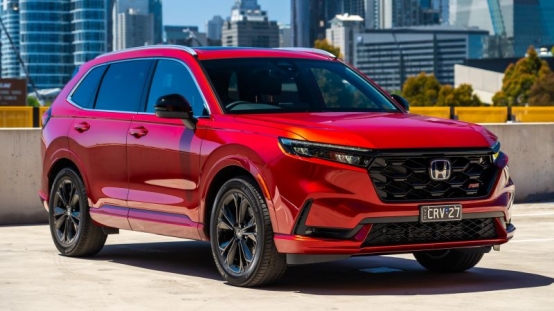The 2025 Honda CR-V continues to impress in the compact SUV segment, offering a practical design, comfortable interior, and a variety of powertrain options suitable for families and daily commuters alike.

Overview and Design
As part of the sixth-generation CR-V launched in 2023, the 2025 model enhances a proven design with subtle updates that convey a contemporary and confident appearance. The bold front grille, defined body lines, and sharp LED lighting reflect Honda’s modern styling approach.
Inside, the cabin benefits from upgraded materials and an intuitive digital interface. Drivers enjoy well-organized controls and an easy-to-use infotainment system, while passengers appreciate spacious seating and a smooth ride. Early owners highlight the CR-V’s reliability and comfort-oriented handling.
Performance and Powertrain Options
The CR-V offers two main powertrains. The base 1.5-liter turbocharged four-cylinder generates roughly 190 horsepower and 179 lb-ft of torque, paired with a responsive CVT. The hybrid variant combines a 2.0-liter engine with dual electric motors for about 204 horsepower. Front-wheel and all-wheel-drive configurations are available for most trims.
On the road, the CR-V provides a composed and comfortable driving experience. The hybrid version delivers smooth power transitions, improved responsiveness, and enhanced fuel efficiency. Honda’s suspension balances stability with comfort, handling road imperfections well, while towing capacity remains moderate—around 1,500 pounds for standard models and 1,000 pounds for hybrids.
Interior, Space, and Comfort
The cabin prioritizes functionality and comfort. Rear legroom measures approximately 39.3 inches, providing ample space for adults. Cargo volume is about 39.3 cubic feet behind the rear seats, expanding to roughly 76.5 cubic feet with seats folded.
The dashboard features a clean horizontal design with a 7-inch display on base trims and a 9-inch touchscreen on higher trims. Soft-touch surfaces and refined finishes enhance the cabin’s appeal, particularly on premium models. Seats are supportive, and improved insulation ensures a quiet ride, even at highway speeds.
Fuel Efficiency and Economy
Fuel economy remains a strong point for the CR-V. The turbo engine achieves about 28 mpg city, 34 mpg highway, and 30 mpg combined for front-wheel-drive models, with slightly lower numbers for all-wheel-drive.
Hybrid models perform even better, offering roughly 43 mpg city, 36 mpg highway, and 40 mpg combined for front-wheel-drive, and 40 mpg city, 34 mpg highway, and 37 mpg combined for all-wheel-drive. EV mode allows short-distance, electric-only driving to reduce fuel use and emissions in urban environments.
Market Position and Value Retention
SUV Model | Starting MSRP (est.) | Key Strengths | Fuel Economy (combined) |
2025 Honda CR-V | $28,500 - $39,000 | Reliability, spacious interior, efficiency | 30–40 mpg |
2025 Toyota RAV4 | $28,000 - $42,000 | Hybrid options, resale value | 30–41 mpg |
2025 Mazda CX-5 | $27,500 - $40,000 | Driving enjoyment, premium interior | 26–28 mpg |
2025 Hyundai Tucson | $27,000 - $38,500 | Warranty coverage, tech features | 29–38 mpg |
2025 Ford Escape | $28,000 - $39,500 | Technology, engine variety | 28–37 mpg |
Honda’s strong reliability continues to support the CR-V’s excellent resale value, with depreciation slower than many competitors and residual values expected above 60% after three years. For buyers seeking a compact SUV that combines versatility, comfort, and long-term value, the 2025 Honda CR-V remains a top choice.
